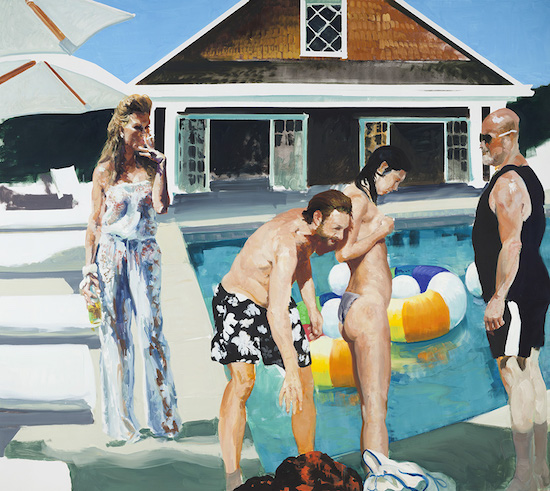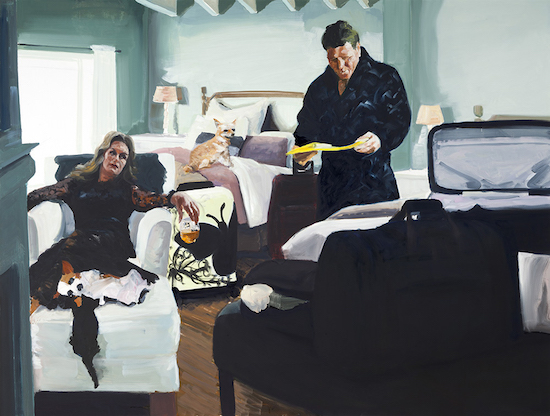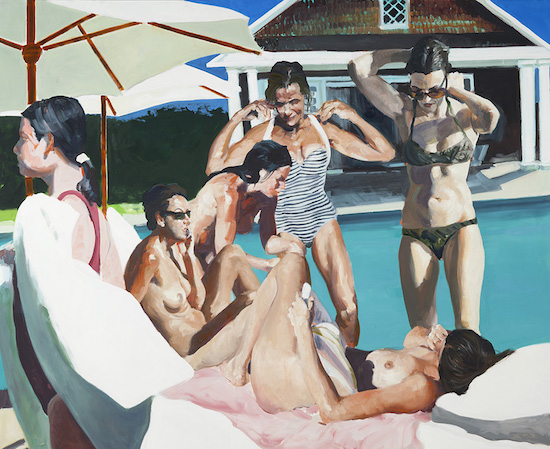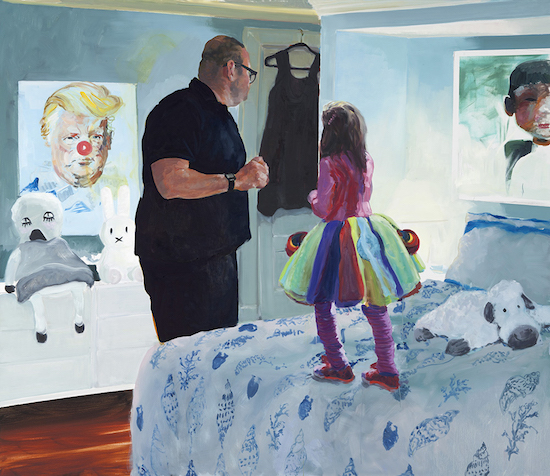Eric Fischl, Worry, 2017, oil on linen, 78 x 90 in. (198.1 x 228.6 cm.), © Eric Fischl. Courtesy of Skarstedt
In a hotel twin bedroom bathed in daylight, a middle-aged man in a plush navy dressing gown carefully examines a sheaf of yellow pages. In an armchair by his side, a woman in evening wear (his wife?) lies slumped, a glass of what looks like whiskey held precariously between thumb and forefinger.
A woman in a short black dress leans against a full-sized mirror to adjust her shoe while talking angrily into a mobile phone. Reflected in the mirror, we see another woman, sat in a bergère beneath a Warhol Marilyn. Making some equal or opposite overtures towards her own footwear (is she fitting it on or taking or off?).
By the side of a pool, a young girl in bikini bottoms hides her breasts with her hands. She is flanked by two men, both facing her – or halfway so – one of whom, apparently fresh from the pool, appears to be reaching for a towel, crumpled on the floor (for her or for him?). To their left, a woman in a sheer white pantsuit over red swimming costume, looks on, smoking, sceptically.
In a child’s bedroom, a young girl stands on the edge of the bed in rainbow tutu. Beside the bed stands a bald, older man, his right hand clenched with concern. Both figures are turned away from us, towards the open door at the back of the room, or perhaps the little black dress hanging from the door. O the left of the frame, a familiar face in a clown costume in a picture on the wall stares out from the canvas, at the viewer.
But the paintings in Eric Fischl’s new show at Skarstedt gallery, London, raise far more questions than even the closest description can solve. Why is this man in his dressing gown as if just waking up and starting the day’s business while the woman by his side is seemingly already drunk and ready to pass out? If that is his wife, why the twin beds? What is he reading so intently? And what time of day is this anyway?
What is the relationship between these two women sharing a space but not an eyeline, at once brought together and divided by the mirror’s reflection? Are they sisters reunited for a funeral? And if so what continues to drive them apart? Have they just come home or are they preparing to go out? And what has made the one on the left look so pissed off?
What has just happened to render this girl topless and which – if either – of these men is her father? What lurks in the darkness of the pool house at back of frame? And why is that man reaching for a towel that looks more sodden than he does?
What fills this man and this girl with apprehension? What lies behind the door? What lies in wait? And what will happen next?
These paintings conjure stories. They always imply a before and an after. They picture people in the midst of mundane yet subtly inscrutable acts. They are looking – though rarely at each other, and almost never beyond the frame at us, their audience. And if they are looking at each other or out at the spectator, they do so somehow under concealment. They veil their glance and glance through veils. The only eyes in these canvases that meet ours unambiguously are the faces of the pictures within the pictures, those of that Warhol Marilyn or the Pierrot with a familiar orange bouffant, the clown who became a president and turned that presidency into an extended act of clowning. Is that what this man and his daughter are so worried about? Or is he merely presiding somehow over their fears?

Eric Fischl, She and Her, 2017, oil on linen, 98 x 110 in. (248.9 x 279.4 cm.) © Eric Fischl. Courtesy of Skarstedt
The Trump presidency, Fischl explains to a gaggle of journalists in the main room of the gallery, feels “like the last ditch effort of white male power, which is why you have the basest, most oafish, most full of shit…” he trails off before finishing with a smirk, “I can’t say enough good things about him!” That mischievous half-smile, so reminiscent of Curb Your Enthusiasm’s Larry David, betrays Fischl, from time to time, as a little bit clown himself, momentarily letting the Serious Artist mask drop to reveal the joker and raconteur, a role he evidently feels more comfortable in. It doesn’t seem like much of a stretch to picture Fischl calling someone a “shmohawk”.
Trump’s appearance on this canvas, Fischl admits, started off as a joke, a “throw-off joke,” he says, “the joke was for me and it’s not an important joke.” The plan had always been to paint him out, replace him with something else, another face staring out of the wall. At one point it was a window onto the world outside (perhaps it still is). “But what became clear,” he continues, “is that this –” he gestures to the leering clown on the wall “– is what’s causing that –” he points to the man’s hands curled up with anxiety. “Even the attempt at humour is not enough to get rid of that.”
But in a way, the Trump administration, as Fischl recognises, represents the end of more than just a certain kind of “white male power”. It is at once a sign and a symptom of the decline of a certain vision of America, a vision of America that has been to a greater or lesser extent the guiding force behind Fischl’s work since his career first took off in the early 80s: an optimistic, aspirational, middle-class America, tied inextricably to the suburbs and the 1950s and the whole post-war liberal consensus, what it made possible and what it was forced to repress. “The optimism was so much greater than the actual problems we were facing,” Fischl says. “You could believe in yourself. The middle class was aspirational. It was a transitional space. None of those things exist anymore. That’s part of the collapse of America.”
It was that America, in both its positive and negative aspects, that Eric Fischl grew up in. Born in New York in 1948, Fischl’s childhood was spent in the suburbs of Nassau County, Long Island, from where his father commuted forty-five minutes each day to his job as a salesman in the city. His mother stayed home to mind Eric and his siblings. In his (2013) autobiography, Bad Boy, Fischl writes frankly of his mother’s thwarted artistic ambitions, her alcoholism and the family’s conspiracy of silence around her drinking, and of her eventual suicide while he was still a young man. When I manage to grab five minutes of his time to talk to him alone during the opening at Skarstedt, he is a little more circumspect.
“I grew up in a household that didn’t have art,” he says, “didn’t look at art –”
But your mother painted, didn’t she? I interrupt.
“No, no,” he shakes his head almost irritably. “She tried at some point. Took some painting lessons. She tried writing a novel. She tried ceramics. She was profoundly frustrated. Because her generation was that generation which was on the cusp of transition from women who did what they were supposed to do to women who chose to do what they wanted to. So she was painfully out of place with the environment.”

Eric Fischl, The Appearance, 2018, oil on linen, 68 x 90 in. (172.7 x 228.6 cm.) © Eric Fischl. Courtesy of Skarstedt
In a way, Fischl’s development as an artist is the perfect mirror of the standard narrative –itself a kind of long term art historical narrative in microcosm – of the abstract artist who toils for years perfecting his craft (and, yes, in these clichéd standard narratives it does tend to be a ‘he’), painting from life, representing reality, before moving slowly, despite official resistance, towards greater degrees of abstraction up until a final breakthrough to a mature style of pure, free expression, rejected at first by the art establishment only to ultimately be embraced as pioneering. Except in Fischl’s case, this narrative runs in reverse.
He studied at CalArts in an early 70s when, as he puts it to me, “painting was declared dead” and further “if painting was dead, figure painting was way dead.” Having painted for years in the prescribed abstract style of his age, struggling to intellectualise his work in the terms fashionable of the moment, his breakthrough – both artistically and commercially – came with his eventual acceptance that what he yearned for all along was figuration, narrative, emotional connection. His subject became the repressed world of the suburbs he had grown up in, the secret worlds hidden behind picket fences.
“Within painting,” he says, “within art, the suburbs was not a recognised genre. It was something that had begun to happen in literature, with [John] Updike and [John] Cheever, and in film, like The Graduate. But it was something where the suburbs was considered a place of no content. And yet, I am of a generation – as are most of my peers – that grew up in the suburbs and we actually know that there’s a ton of content in the suburbs. So part of it was about, how do you forge a permission inside the rather restrictive definitions of art and of painting so people can see that the suburbs is as poignant and powerful as the demi monde or the pastoral or the historic?”
Alongside Updike and Cheever – and Mike Nichols and David Lynch – Fischl became one of the great poets of the suburbs, precisely because he was aware, as much as those novelists and film directors were, of what was repressed and excluded by those smiling faces and picket fences. In Bad Boy, early on, while still talking about his childhood, he says, “I became increasingly aware of the differences between what things looked like and how I felt.” I ask him if this remains the subject of his work, if this is still the gap which he strives to capture.
“Yes,” he says. “Definitely. For example, here –” he points at the painting behind him, a canvas called Pretzel featuring six women of different ages, all apparently relaxing by the side of a pool, “the setting of this painting would imply a different level of comfort than is actually expressed in the body language of the characters in there. It’s almost like whatever they invested in the identity that is associated with comfort or security or whatever, is betrayed when you see their feelings manifested in terms of how their body is shown.”

Eric Fischl, Pretzel, 2017, oil on linen, 80 x 98 in. (203.2 x 248.9 cm.), © Eric Fischl. Courtesy of Skarstedt
It strikes me as quite a cinematic aspiration, I suggest. I’m thinking of the gap between what is said and what is true in Eric Rohmer, of Ozu, and Lynch, too.
“I grew up with television,” he replies, “which was mostly, at that time, old time movies, or there’d be cartoons and Howdie Doodie. Or, as young kids and teenagers, we would go to the movies, or we’d look at magazines. So you had the photo and the film visual language way before I had the painting language. People always connect the way I narrate as a filmic thing and I’m sure that’s true. But there’s a profound difference within the creative mind between being able to extend the emotional through a time sequence that is linear, as opposed to a painter which takes it and moves it down into a singular frozen moment. They’re just different sensibilities. I’ve always been asked would you like to make a film? I would have zero idea what to do. I don’t think I could sustain it.”
Still, there remains something of cinema’s sense of montage in Fischl’s images. Light sources appear contradictory. Figures seem to be collaged together, artificially clumped together in the same scene. What he reveals, perhaps, is the sense in which urban social reality itself is a collage. We all share space, while remaining alone, isolated in our own inner lives. This is what we see in Fischl’s paintings.
Later that evening, at the Arts Club in Mayfair where Fischl is subjected to a live Q&A before an invited audience in a basement bar, the joker is back in force. “This room makes me feel like we should be singing,” he smirks from his stool on the spotlit stage. “I’m just saying…”
Painting Trump as a clown, he says now, was “a way of trying, through humour, to understand what’s happening. But I’ve got to the point where I can’t do it anymore, because the humour’s not working…” Don’t worry, Fischl is still funny, still an incisive forensic pathologist of the U.S. body politic; maybe it’s America itself that lost the joke.
Eric Fischl: Presence Of An Absence, is at Skarstedt, London, until 26 May


